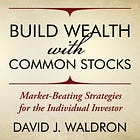Course Module 112: Assessing Downside Risks
Subject matter objective: How to screen company risk profiles to uncover quality stocks with the highest potential for preserving invested capital

Summary
Managing downside risk is more controllable than trying to predict future returns.
High-quality common stocks offer the best opportunities for portfolios to outperform the market on the downside, with a lesser percentage drop than benchmark index averages.
A risk understood, accepted, and well-managed becomes a risk worth taking.
When assessing the downside risk, focus on the enterprise’s economic moat, debt coverage, price volatility, and short interest on the outstanding shares.
Thoughtful, disciplined, and patient investors manage the downside risk and let the upside take care of itself.
Managing downside risk is more controllable than trying to predict future returns. A top priority of defensive investors is the preservation of capital; thus, assessing downside risk is an essential research component and measurement tool for thoughtful investors.
Seek profitable, predominantly dividend-paying, wide and narrow moat companies that are less volatile than the market and have the free cash flow and liquidity to pay the short- and long-term bills. Nonetheless, active investors want to be aware of the perils of investing in the common shares of publicly traded companies.
Regardless of the cause or ultimate duration, any market downturn delivers a stark reminder that managing risk is paramount to disciplined investing.
Course Module 112 Syllabus
Subject matter objective: How to screen company risk profiles to uncover quality stocks with the highest potential for a limited downside that preserves precious invested capital. In doing so, we assign a grade to individual common stocks based on several measures of investment risk.
Alpha achievement more often happens in down markets
Lessons in risk management
Returns are unpredictable, but risks are controllable
Four vital business areas that assess the underlying stock's measurable risk
How to assign a downside risk profile or rating
Manage the downside while allowing the upside to take care of itself
Course Module 112 voluntary action items and suggested resources
Alpha Happens on the Downside as Well
Although a trading day, week, month, or quarter never defines a market sample size, in my personal experience, market outperformance more often happens on the downside.
A portfolio of quality companies purchased at sensible prices that underperforms the market when it is flying high has the propensity to outperform the market on the downswing, thus increasing the potential to exceed the market over time.
Quality Value Investing (QVI) relies on select broad indicators that measure the downside risk of the stocks in our family portfolio and residing in the QVI Real-Time Portfolios. Any sudden downturn in the market reminds us of the cornerstone of disciplined investing: understanding the downside risk profile for each holding.
A practical exercise for self-directed investors is due diligence in uncovering and managing the downside risk of owned or targeted publicly traded companies. Those assessing risk tend to experience less volatility in bear market cycles or during corrections from surprise socioeconomic or geopolitical events.
Lessons in Risk Management
Markets are forever rising or capitulating. Trying to time the inevitable roller coaster ride is the stock market equivalent of predicting volcanic eruptions. Nevertheless, many investors embark on such a journey despite a subconscious understanding of the contrary.
The counterproductive way to manage investment risk is the equivalent of the herd riding the gravy train up the mountain with a self-assured buy and getting caught in a runaway train down to the valley, resulting in a money-losing sell. Second-level investors do the exact opposite by becoming sellers as stocks trend upward and buyers as the market heads south. The pattern followed by disciplined, quality-driven value investors generates profits from the inept who act against glaring lessons from market history.
Investors or traders foreseeing the next market trend or target price are as rare as a sports bettor who predicted the Philadelphia Eagles' defeat of the favored New England Patriots in Super Bowl LII. The win was predestined after the Eagles executed a fourth-down trick pass play for the record books. The daring play at the end of the second quarter, resulting in the first quarterback touchdown reception in the history of Super Sunday, was indeed risky. If my memory serves me, in post-game interviews, Eagles head coach Doug Pederson implied it was a play the team practiced with diligence and brought to the game with the confidence to execute with precision.
The lesson for disciplined investors is that a risk assessed, understood, and well-managed is worth taking.
Earn premium subscription rewards when referring friends, family, or colleagues to QVI:
Returns Are Unpredictable
Risk Is Controllable
Measuring, understanding, and accepting the downside price risk of a company and its common shares from an unforgiving market offer the best opportunities for investing with a tolerable, asymmetric risk/reward profile.
Successful investors are rewarded more for limited portfolio downside in bear markets from a disciplined approach to risk-managed investing than from the upside in bull markets driven by exuberant participants.
As often happened during the post-Great Recession boom, the inevitable downturns develop into official corrections—10 percent off the market closing highs—or head fake buying opportunities in a continuing bull market. Regardless of the cause and effect, it is imperative to understand our risk profile before buying the common shares of value-priced, quality companies.
When executing, patient investors enjoy the magic of annualized compounding of total return over several market cycles from an acute understanding of the downside risk. They throw a cast net encompassing wide margins of safety. Defensive investors revisit the risk profiles of the holdings with regularity following the initial purchases.
After reading the required disclosures and background information, we’ll uncover four vital business areas that assess the company and underlying stock's measurable risk. Course Module 112 concludes with action items and suggested resources.
Disclosure: I/we have beneficial long positions in the common shares of all 18 companies represented by the QVI Concentrated Portfolio in our family portfolio.
I wrote this course myself, and it expresses my own opinions. I am not receiving compensation for it other than from Substack paid subscriptions. I have no business relationship with any company whose stock is mentioned in this module.
Disclosure: David J. Waldron’s Quality Value Investing course modules, research reports, and model portfolios are for informational purposes only. The accuracy of the data cannot be guaranteed. Narrative and analytics are impersonal, i.e., not tailored to individual needs nor intended for portfolio construction beyond his family portfolio, which is presented solely for educational purposes. David is an individual investor and author, not an investment adviser. Readers should always engage in their own research or due diligence and consider (as appropriate) consulting a fee-only certified financial planner, licensed discount broker/dealer, flat fee registered investment adviser, certified public accountant, or specialized attorney before making any investment, income tax, or estate planning decisions.
About the Writer
David J. Waldron is the contributing editor of Quality Value Investing and author of the international-selling book Build Wealth with Common Stocks: Market-Beating Strategies for the Individual Investor. David’s mission is to inspire the achievement of his readers’ financial goals and dreams. His work has been featured on Seeking Alpha, TalkMarkets, ValueWalk, MSN Money, Yahoo Finance, QAV (Australia’s #1 Value Investing Podcast), Money Life with Chuck Jaffe, LifeBlood with George Grombacher, The Acquirer’s Multiple, Amazon, Barnes & Noble, Apple Books, the BookLife Prize, and Publisher’s Weekly. David received a Bachelor of Science in business studies as a Garden State Scholar at Stockton University and completed The Practice of Management Program at Brown University.
Bonus: Founding Subscribers of QVI on Substack are eligible to receive a personalized complimentary copy of the case laminate hardcover edition of the book from the author.
Keep reading with a 7-day free trial
Subscribe to Quality Value Investing to keep reading this post and get 7 days of free access to the full post archives.







